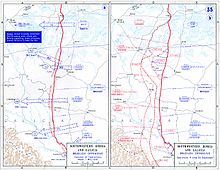
Back هجوم بروسيلوف Arabic Brusilov hücumu Azerbaijani Брусілаўскі прарыў Byelorussian Настъпление на Брусилов Bulgarian Ofensiva Brussílov Catalan Brusilovova ofenzíva Czech Brussilow-Offensive German Brusilov-ofensivo Esperanto Ofensiva Brusílov Spanish Brussilovi läbimurre Estonian
| Brusilov offensive (Fourth Battle of Galicia) | |||||||||
|---|---|---|---|---|---|---|---|---|---|
| Part of the Eastern Front of World War I | |||||||||
 Left: Plan of May. Right: Frontline at the end of Brusilov offensive in September 1916. | |||||||||
| |||||||||
| Belligerents | |||||||||
|
|
| ||||||||
| Commanders and leaders | |||||||||
|
|
| ||||||||
| Strength | |||||||||
|
Initial: 40+ infantry divisions (573,000 men) 15 cavalry divisions (60,000 men) Overall: |
Initial: 39 infantry divisions (437,000 men) 10 cavalry divisions (30,000 men) Overall: 1,061,000 in 54 Austrian divisions and 24 German divisions | ||||||||
| Casualties and losses | |||||||||
|
Total: 500,000–1,440,000 casualties |
Total: 845,000 – 1,500,000 casualties[8][9] | ||||||||

The Brusilov offensive (Russian: Брусиловский прорыв Brusilovskiĭ proryv, literally: "Brusilov's breakthrough"), also known as the "June advance",[10] of June to September 1916 was the Russian Empire's greatest feat of arms during World War I, and among the most lethal offensives in world history. The historian Graydon Tunstall called the Brusilov offensive the worst crisis of World War I for Austria-Hungary and the Triple Entente's greatest victory, but it came at a tremendous loss of life.[11] It was arguably the most successful offensive in the entirety of the First World War.[12] The heavy casualties eliminated the offensive power of the Imperial Russian Army and contributed to Russia's revolution the next year.
The offensive involved a major Russian attack against the armies of the Central Powers on the Eastern Front. Launched on 4 June 1916, it lasted until late September. It took place in eastern Galicia (present-day northwestern Ukraine), in the Lviv and Volyn Oblasts. The offensive is named after the commander in charge of the Southwestern Front of the Imperial Russian Army, General Aleksei Brusilov. The largest and most lethal offensive of the war, the effects of the Brusilov offensive were far-reaching. It relieved German pressure on French forces at Verdun, and helped to relieve the Austro-Hungarian pressure on the Italians. It inflicted irreparable losses on the Austro-Hungarian Army, and induced Romania to finally enter the war on the side of the Entente. The human and material losses on the Russian side also greatly contributed to the onset of the Russian Revolution the following year.[13] Largest battle in World War I according to the total losses and forces of the parties.
- ^ a b Мерников А. Г., Спектор А.А. Всемирная история войн. – Минск., 2005. – стр. 428
- ^ Брусиловский прорыв в симбирской и самарской периодической печати и его итоги
- ^ Tucker, Spencer C. (2002). The Great War, 1914–1918 (Warfare and History). Routledge. p. 119. ISBN 978-1-134-81750-4.
- ^ Нелипович, С.Г. Наступление Юго-Западного фронта в кампанию 1916 г. (Брусиловский прорыв): Борьба резервов/ Военно-исторические исследования в Поволжье. Вып. 5. - Саратов, 2003, Таблица 5 Соотношение потерь сторон на Русском ТВД с начала наступления ЮЗ фронта по 18/31 декабря 1916 года
- ^ Haeften 1936, p. 566.
- ^ Keegan 2000, p. 435.
- ^ Turkey In The First World War: Galicia Archived 20 March 2017 at the Wayback Machine. Turkish losses for September were: unknown on the action of September 2. 7,000 on the actions of September 16/17. 5,000 on the actions of September 30.
- ^ Нелипович, С.Г. Наступление Юго-Западного фронта в кампанию 1916 г. (Брусиловский прорыв): Борьба резервов/ Военно-исторические исследования в Поволжье. Вып. 5. - Саратов, 2003, Таблица 5 Соотношение потерь сторон на Русском ТВД с начала наступления ЮЗ фронта по 18/31 декабря 1916 года
- ^ ones D. R. The Imperial Army in World War I, 1914—1917 // The Military History of Tsarist Russia (англ.) / Ed. by F. W. Kagan, R. Higham. — N. Y.: Palgrave, 2002. — P. 227—248. — ISBN 978-0-230-10822-6.
- ^ Biography of one of the participants (in Russian)
- ^ Tunstall 2008, pp. 30–53.
- ^ Millar, James R., ed. (2004). Encyclopedia of Russian History. New York: Macmillan Reference. pp. 932, 1680. ISBN 0-02-865693-8.
- ^ Tucker, Spencer C. (2002). The Great War, 1914–1918 (Warfare and History). Routledge. p. 119. ISBN 978-1-134-81750-4.
© MMXXIII Rich X Search. We shall prevail. All rights reserved. Rich X Search